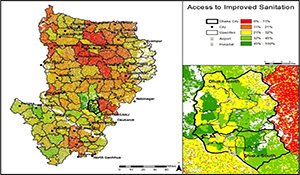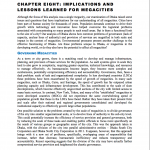Implications and Lessons Learned for Megacities

Implications and Lessons Learned for Megacities.
Author | Editor: Desjardins, A. (NSI, Inc).
Our analysis of Dhaka shows how common problems of governance (lack of capacity, unclear lines of authority) and provision of services are magnified in both scale and impact in the context of megacities.
Although the focus of this analysis was a single megacity, our examination of Dhaka raised some issues and questions that have implications for our understanding of all megacities. Cities have been part of human society for thousands of years. Population demands continue to drive their growth while technology and innovation have helped overcome the logistical problems associated with concentrating so many people in such small areas. But is there a functional limit to the size of a city? Our analysis of Dhaka shows how common problems of governance (lack of capacity, unclear lines of authority) and provision of services are magnified in both scale and impact in the context of megacities. Environmental pressures present another challenge to the effective functioning of Dhaka. Are these problems unique to Dhaka, or megacities in the developing world, or do they also have the potential to affect all megacities?
As a town or city grows, there is a matching need to develop and manage infrastructure, planning, and provision of basic services for the population. As such systems grow in scale they tend to also grow in complexity, requiring greater expertise, technical knowledge, and resources to manage effectively. As bureaucracies become larger, they become more complex and cumbersome, potentially compromising efficiency and accountability. Governance, then, faces a dual problem: scale of task and organizational complexity. In less developed countries (LDCs) these problems have been exacerbated by the speed of growth of megacities. In many such megacities, such as Dhaka, Cairo, and Santiago, the speed of growth has far outpaced urban planning capacity and infrastructure development. This has contributed to the scale of slum developments, which become effectively ungoverned sections of the city with limited access to many basic services. In contrast, New York, Tokyo, and many of the “established” megacities in more developed countries (MDCs) did not experience the same overwhelming speed of population growth that those in the LDCs have faced. Rather they have taken their present form and scale after their national and regional governments consolidated and developed the institutional capacity to effectively govern large urban populations.
One possible solution to the problems created by the scale of megacities is to divide governance of the city into smaller organizational units, or to devolve lines of authority to the sub-city level. This could potentially increase the efficiency of service provision and general governance, both by reducing the scale of these tasks and enabling public officials to focus more specifically on the needs of various groups or geographic areas of the city. This was the approach taken in Dhaka, with the division of the city into parallel administrative entities – Dhaka South City Corporation and Dhaka North City Corporation in 2011. It appears, however, that this approach brings with it a new set of problems, specifically, overlapping areas of responsibility that increase, rather than decrease, bureaucratic inefficiency and reduces transparency and accountability. Recent reporting suggests that the division of the city may have actually further compromised service provision and heightened the chaotic governance.
When considering the governance and administrative needs of megacities several critical factors emerge. First, governing capacity and technical expertise is essential to the creation of a functioning megacity capable of meeting the needs of all of its residents. Second, the speed with which a city grows to become a megacity places increasing pressures on governance and planning; the faster a city grows, the more likely it is to outstrip the ability of any governing authority to keep up. This suggests that identifying cities that are growing at a rapid rate and intervening early to increase governing capacity and plan for future growth could relieve some of the negative (crime, environmental quality, insufficient basic services) aspects of megacities. Better understanding of the causes of rural-urban migration may also offer the potential to slow the speed of growth of some of the most vulnerable megacities, such as Dhaka. It is possible, for example, that greater investment in rural development may help stem the tide of migration to major urban centers, providing greater potential for planned development and strengthening of governing capacity as cities grow.

Comments